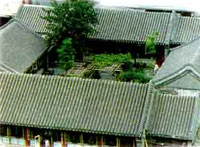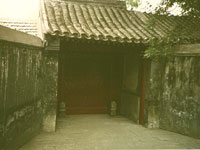|
Courtyard (Siheyuan)
( chinadaily.com.cn)
Updated: 2004-01-14 14:26
 Beijing's traditional courtyards (siheyuan) still house many of the city's residents within the second ring road, which marks the limits of old Beijing. Siheyuan line the small lanes, or hutongs, that make up most of the central part of the city. However, many of the siheyuan, which consist of four rooms around a central yard, are being torn down at present, and quite a large proportion of those who have enjoyed courtyard living for generations have now moved to high-rise blocks of flats in new residential areas. Beijing's traditional courtyards (siheyuan) still house many of the city's residents within the second ring road, which marks the limits of old Beijing. Siheyuan line the small lanes, or hutongs, that make up most of the central part of the city. However, many of the siheyuan, which consist of four rooms around a central yard, are being torn down at present, and quite a large proportion of those who have enjoyed courtyard living for generations have now moved to high-rise blocks of flats in new residential areas.
The siheyuan is a typical form of ancient Chinese architecture, especially in the north of China. They are designed to make it as comfortable as possible to live in a climate that is at times inhospitable. For instance, the siheyuan are enclosed and inward facing to protect them from the harsh winter winds and the dust storms of spring. Their design also reflects the traditions of China, following the rules of feng shui and the patriarchal, Confucian tenants of order and heirarchy that were so important to society.
It is normal for the four rooms to be positioned along the north-south, east-west axes. The room positioned to the north and facing the south is considered the main house and would traditionally have accomodated the head of the family. The rooms adjoining the main house are called " side houses" and were the quarters of the younger generations or less important members of the family. The room that faces north is known as the "opposite house" and would generally be where the servants lived or where the family would gather to relax, eat or study. The gate to the courtyard is usually at the southeastern corner. Normally, there is a screen-wall inside the gate so that outsiders cannot see directly into the courtyard and to protect the house from evil spirits. Outside the gate of some large siheyuan, it is common to find a pair of stone lions. The gates are usually painted vermilion and have large copper door rings. All the rooms around the courtyard have large windows facing onto the yard and small windows high up on the back wall facing out onto the street. Some do not even have back windows. Some large compounds have two or more courtyards to house the extended families that were a mark of prosperity in ancient times.
 Housing is now one of the most difficult problems facing Beijing, a city that is growing both spatially and in terms of population at a fast rate. As such, one siheyuan now often houses several families and many yards have been taken up with additional rooms. This contributes to the "rabbit-warren" nature of the hutongs. The living conditions in many siheyuans are now considered squalid, especially as very few have private toilets or washrooms. To solve the apparent problems of overcrowding, the siheyuan are being torn down and replaced by modern blocks of flats. There are, however, still some grand siheyuan in Beijing that have been preserved in all their former glory. Mainly built for nobles and high officials before the turn of the century, many have been turned into museums, and others are being lived in by present-day governmental officials or used as government offices. Housing is now one of the most difficult problems facing Beijing, a city that is growing both spatially and in terms of population at a fast rate. As such, one siheyuan now often houses several families and many yards have been taken up with additional rooms. This contributes to the "rabbit-warren" nature of the hutongs. The living conditions in many siheyuans are now considered squalid, especially as very few have private toilets or washrooms. To solve the apparent problems of overcrowding, the siheyuan are being torn down and replaced by modern blocks of flats. There are, however, still some grand siheyuan in Beijing that have been preserved in all their former glory. Mainly built for nobles and high officials before the turn of the century, many have been turned into museums, and others are being lived in by present-day governmental officials or used as government offices.
|
